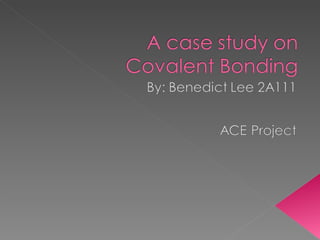A case study on covalent bonding(ace)
- 1. ╠²
- 2. Formed between atoms of non-metals A type of chemical bonding where atoms share electrons to obtain a stable atomic structure Covalent bonding of 2 Hydrogen atoms and 1 oxygen atom, forming H 2 O(water)
- 3. While most covalent compounds are formed between atoms of non-metals, two chemical compounds are exceptions to this rule Aluminium chloride (AlCl 3 ) Beryllium chloride (BeCl 2 )
- 4. Electronegativity is a measure of the tendency of an atom to attract a bonding pair of electrons The Pauling scale is the most commonly used Fluorine (the most electronegative element) is assigned a value of 4.0, and values range down to caesium and francium which are the least electronegative at 0.7
- 5. Consider a bond between two atoms, A and B. If the atoms are equally electronegative, both have the same tendency to attract the bonding pair of electrons, and so it will be found on average half way between the two atoms. A ------------------------- B
- 6. What happens if B is slightly more electronegative than A? - B will attract the electron pair more than A does That means that the B end of the bond has more than its fair share of electron density and so becomes slightly negative A ------------------------- B
- 7. 1 x Aluminium(2.8.3) 3 x Chlorine(2.8.7) In the case of aluminium chloride, the electron pairs are dragged back towards the aluminium to such an extent that the bonds become covalent
- 8. 1 x Beryllium(2.2) 2 x chlorine(2.8.7) Chlorine ------------------------- Beryllium
- 9. Beryllium is a small atom and has quite a high electronegativity compared with the rest of the Group It attracts a bonding pair of electrons towards itself more strongly than magnesium and the rest do In order for an ionic bond to form, the beryllium has to let go of its electrons. It is too electronegative to do that.
- 10. Chlorine is fairly large with a low charge (-) so electrons are easily pulled away from it. Chlorine ------------------------- Beryllium
- 11. http://en.wikipedia.org/wiki/Covalent_bonding sixthsense.osfc.ac.uk http://en.wikipedia.org/wiki/Aluminium_chloride http://www.chemguide.co.uk/inorganic/group2/beryllium.html http://www.thestudentroom.co.uk/showthread.php?t=1133148 http://www.chemguide.co.uk/atoms/bonding/electroneg.html











